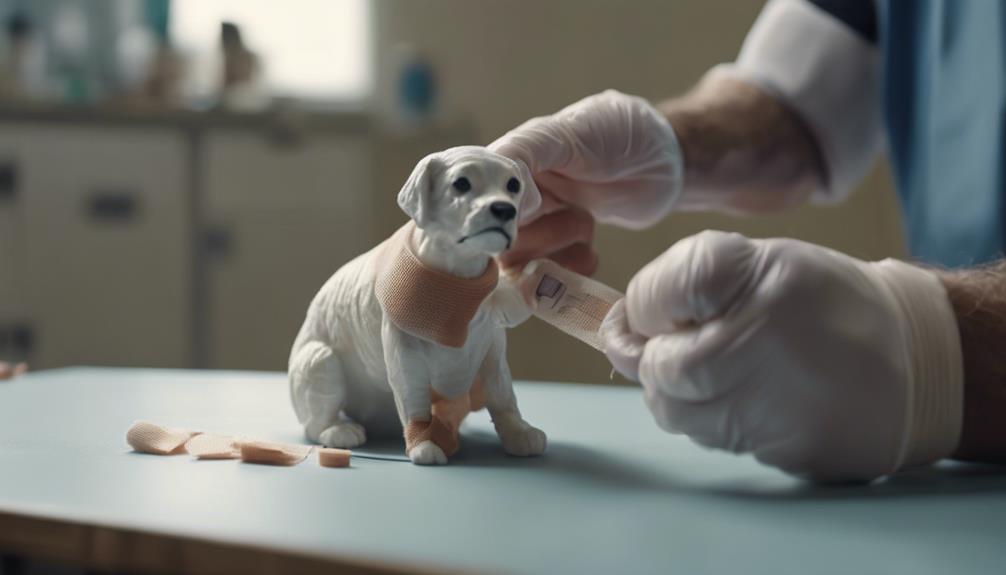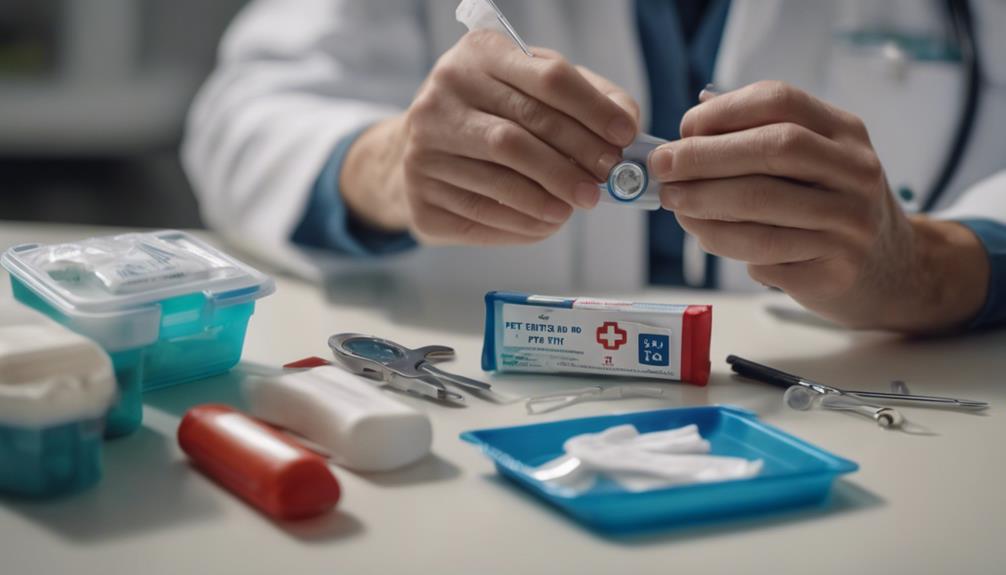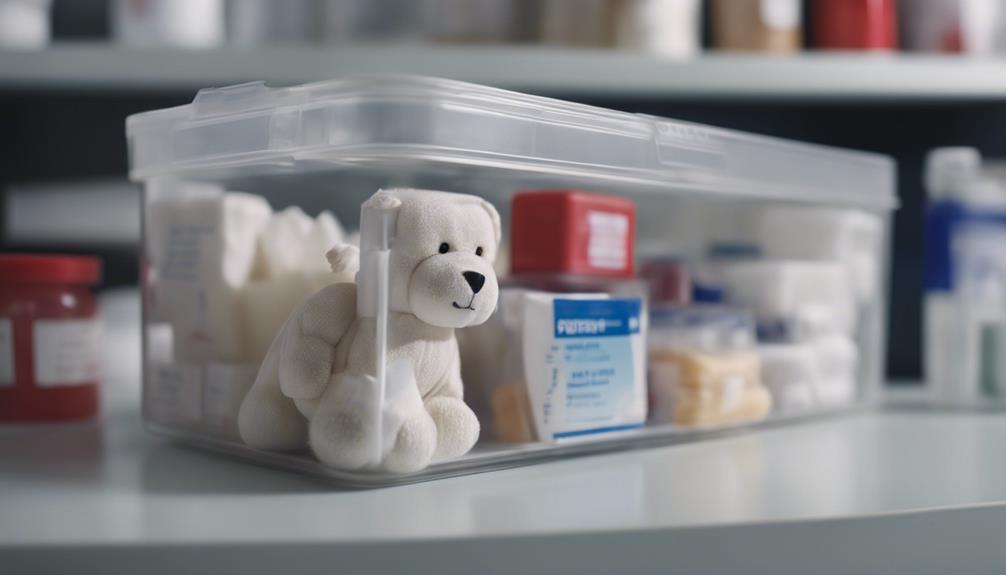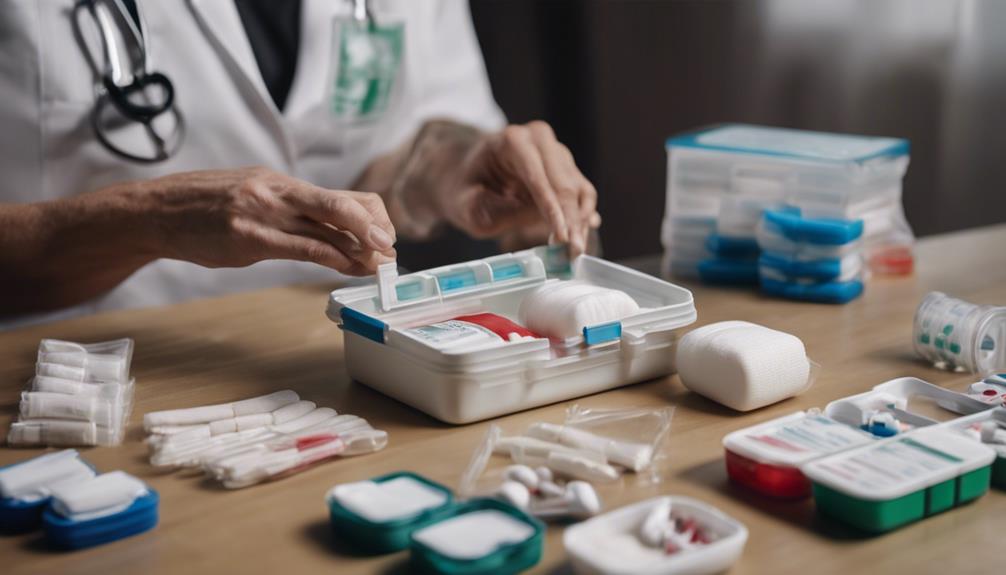Ensuring the safety and well-being of our pets is a responsibility that all pet owners hold dear. When faced with unexpected emergencies, having a well-equipped pet first aid kit can make all the difference.
From basic supplies to specialized tools, the contents of such a kit can mean the distinction between a minor mishap and a major crisis. A vet's perspective on assembling and maintaining a pet first aid kit can provide invaluable insights into safeguarding our furry friends.
Let's explore the essential components and expert tips for creating a comprehensive pet first aid kit that every pet owner should consider.
Key Takeaways
- Sturdy container with essential items
- Store kit near pet supplies
- Learn basic first aid procedures
- Regularly update and train family members
Essential Items for DIY Pet First Aid Kit
When assembling a DIY pet first aid kit, it is essential to include key items such as a container, a card with emergency information, styptic powder, tweezers, and small scissors.
The container should be sturdy and waterproof to protect the contents. The emergency information card should detail your pet's medical history, allergies, and contact information for your veterinarian.
Styptic powder helps stop bleeding in case of nail trimming accidents, while tweezers and small scissors are useful for removing ticks, thorns, or debris from your pet's fur.
These items form the foundation of a well-equipped pet first aid kit, ensuring you can provide immediate care to your furry friend in times of need.
Importance of Storage and Accessibility
The storage and accessibility of a pet first aid kit are crucial factors in ensuring prompt and effective care for your furry companion during emergencies. It is essential to keep the kit in a location that is easily reachable in case of an urgent situation.
Here are four key points to consider:
- Keep nearby pet essentials: Store the first aid kit near other pet supplies for quick access.
- Easily accessible: Ensure that the kit can be grabbed quickly without any obstacles.
- Better to be safe than sorry: Proximity and accessibility can make a significant difference in providing timely care.
- Expect the best, prepare for the worst: Being prepared for emergencies includes having the kit readily available for immediate use.
Steps to Use Pet First Aid Kit

To effectively utilize a pet first aid kit during emergencies, it is essential to remain composed and carefully assess the situation at hand. Start by ensuring your own safety before approaching the pet.
Follow any instructions provided in a pet first aid manual that may come with the kit. Use the tools included in the kit, such as tweezers for removing foreign objects or styptic powder for minor cuts to stop bleeding.
Keep the pet secure and calm to prevent further injuries. Monitor the pet's condition closely, noting any changes. Remember that the first aid kit is meant to provide immediate care until professional help can be obtained for more severe injuries.
Tips for Pet First Aid Preparedness
For optimal readiness in handling pet emergencies, prioritize acquiring essential skills and maintaining a well-equipped pet first aid kit. Here are some tips for pet first aid preparedness:
- Learn basic first aid procedures
- Regularly check and update the kit
- Train family members on kit use
- Practice using the kit
Benefits of Having a Pet First Aid Kit

Optimizing pet care in emergencies, the possession of a well-stocked pet first aid kit offers immediate benefits by enabling prompt and effective response to minor injuries. Having a pet first aid kit can prevent infections by allowing you to quickly clean and treat wounds. This reduces stress during emergencies as you are equipped to handle the situation efficiently. By having the necessary supplies readily available, the chances of a quick recovery for your pet are increased. Moreover, owning a pet first aid kit showcases responsible pet ownership and preparedness for unforeseen circumstances.
| Benefits of Having a Pet First Aid Kit |
|---|
| Immediate care for minor injuries |
| Prevents infections |
| Reduces stress during emergencies |
| Increases chances of a quick recovery |
First Aid Procedures for Pet Owners
Understanding essential first aid procedures is crucial for pet owners in ensuring the well-being of their furry companions during emergencies.
- Stay Calm: Remain composed to assess the situation accurately.
- Follow Instructions: Adhere to first aid guidelines and instructions carefully.
- Utilize Tools Properly: Use the tools in the pet first aid kit as instructed.
- Monitor and Comfort: Keep the pet secure, calm, and monitor their condition closely.
These procedures are vital in providing immediate care to pets in distress. By staying prepared and knowing how to respond effectively in emergencies, pet owners can greatly contribute to their pet's safety and well-being until professional help is available.
Maintenance and Training for the Kit

To ensure the effectiveness of your pet first aid kit and the readiness of your household in handling emergencies, regular maintenance and training are essential components to prioritize.
Maintenance involves checking the kit regularly for expired items, replacing used supplies, and ensuring everything is in working order.
Training family members on how to use the kit is crucial for quick and effective response during emergencies. Practice scenarios can help familiarize everyone with the tools and procedures.
Additionally, staying informed about basic first aid procedures for pets is key.
Managing Severe Injuries With the Kit
When faced with severe injuries in pets, the proper utilization of a well-equipped pet first aid kit can make a significant difference in providing timely and effective care.
Here are key steps to manage severe injuries using the kit:
- Assess the Situation: Evaluate the severity of the injury before providing any treatment.
- Control Bleeding: Use bandages or gauze to apply pressure on wounds to stop excessive bleeding.
- Stabilize Fractures: Immobilize the injured area using splints or bandages to prevent further damage.
- Protect Wounds: Clean and cover wounds with sterile dressings to prevent infections and aid in the healing process.
Responsibility and Care With the Kit

In ensuring the optimum utilization of a pet first aid kit, maintaining a sense of responsibility and care is paramount for pet owners facing emergencies. Responsibility involves regularly checking the kit for expired items, ensuring all components are in place, and storing it in a designated, easily accessible location.
Care entails handling the kit with caution to prevent damage to its contents, as well as keeping it out of reach of children and pets to avoid misuse. Additionally, pet owners should familiarize themselves with the items in the kit, know how to use them effectively, and be prepared to act swiftly and calmly in crisis situations.
Conclusion
In conclusion, creating and maintaining a pet first aid kit is essential for responsible pet ownership. By having the necessary items on hand and being prepared to handle emergencies, pet owners can ensure the safety and well-being of their beloved animals.
Regular maintenance and training are key to effectively using the kit in times of need. With proper care and preparedness, pet owners can demonstrate their commitment to the health and welfare of their furry companions.




